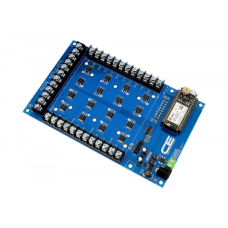PCA9685 16-Channel 12-Bit 5-Amp High-Current N-Channel PWM Pulse Width Modulation Light Dimmer with IoT Interface
DC LED and Incandescent Light Dimming is easier than ever using your favorite IoT communications platform.
Equipped with our IoT interface, plug-in your favorite IoT communication module and develop firmware control lights from anywhere in the world! The NCD IoT interface support Particle Electron for cellular access. Use the Particle Photon to control this device over WiFi. The IoT interface also supports Bluz (Bluetooth BLE) or you can use one of our adapters to plug in Arduino Nano, Arduino Micro, USB, PyCom WyPy, directly on-board! Plug in the SI I2C adapter for interface to Raspberry Pi, BeagleBone, or Arduino Uno. The NCD IoT interface standard makes it easy to connect to just about any computer or microcontroller!
Based on our plug-and-play I2C interface standard, all NCD IoT devices support I2C communications using a I2C expansion port, making it easy to expand to a wide variety of sensors, relay controllers, PWM controllers, and much more!
This controller consists of a PCA9685 16-Channel I2C 12-Bit PWM controller connected to 16 high-current N-Channel FETs. The PCA9685 support 62 devices per I2C port, allowing you to control up to 992 channels over a cellular cloud connection. This controller is configured as a “Low-Side” driver.
Operation is very easy, simply connect an external light to a power supply up to 100VDC and feed the ground of the light through this controller. This controller will switch the ground on and off at high-speed, causing a light dimming effect with 4096 brightness levels per channel.
This controller only uses the I2C SCL and SDA lines of the Particle Electron, leaving all other I/O pins available for other applications. Our GitHub repository (ControlEverythingCom) contains a complete library ready to use with your Particle Electron, Photon, or Bluz, eliminating the need to write code to control this device.
This light dimmer is also compatible with a 418MHz Key Fob receiver (Part Number: PKFR sold separately), allowing your Particle Electron to receive and process remote Key Fob commands up to 750 feet away. Up to 40 remote controls may be associated to the PKFR. Program your Particle Electron to control relays in any way you can imagine through the use of a remote Key Fob. Compatible with 1, 2, 3, 4, 5, and 8-Button MS Series Key Fobs from Linx Technologies.
NOTE: This controller requires a 12VDC Power Supply for proper operation. A separate power supply is recommended for external incandescent or high-power LED lights. This controller is capable of switching 100VDC at 5 Amps, and is able to switch considerably more current at lower voltages. Experimentation is recommended at lower voltages, we suggest a FET operating temperature of 125º Fahrenheit or less. Integrated I2C Expansion port makes this device fully compliant with our complete line of I2C devices, allowing you to combine sensors, relay controllers, more light dimmers, and many other types of devices to a single IoT communications module.
What is the NCD IoT Interface?
The NCD IoT Interface provides users with a means of changing or upgrading the IoT communications technology as new technologies emerge. The NCD IoT Interface is directly compatible with Particle Photon for WiFi communications, Electron for Cellular Communications, Bluz for Bluetooth. Optionally, adapters may be installed to provide a direct interface to Arduino Nano, Micro, USB, PyCom WyPy, Onion Omega, Raspberry Pi, and much more. The NCD IoT interface allows you to re-use your hardware so it never becomes obsolete! Based on I2C communications, the NCD IoT Interface uses only 2 GPIO lines of your microcontroller, freeing the rest of your CPU for other tasks.
Unlimited I2C Expansion
Based on our plug-and-play I2C interface standard, all NCD IoT devices are equipped with a I2C expansion port, making it easy to expand to a wide variety of sensors, current monitors, relay controllers, PWM controllers, and much more! We are always designing new expansions for our plug-and-play I2C framework. We are dedicated to building a product line of interconnected devices to simplify all forms of automation. Re-use or upgrade your hardware in seconds by selecting the modules that best fit your needs, and chaining them together using the included I2C expansion cables!
Features
- For LED or Incandescent Light Dimming
- High Resolution 12-Bit Light Dimming
- 4096 Brightness Levels per Channel
- 16-Channels of Light Dimming
- 5-Amps per Channel at 100VDC
- N-Channel Open Collector Outputs
- Directly Compatible with Photon, Electron, and Bluz
- Adaptable to Arduino, Raspberry Pi, BeagleBone, Onion and More
- Expandable to Control Over 900 Channels
- I2C Expansion Port with I2C Cable Included
Enter the code in the box below:



